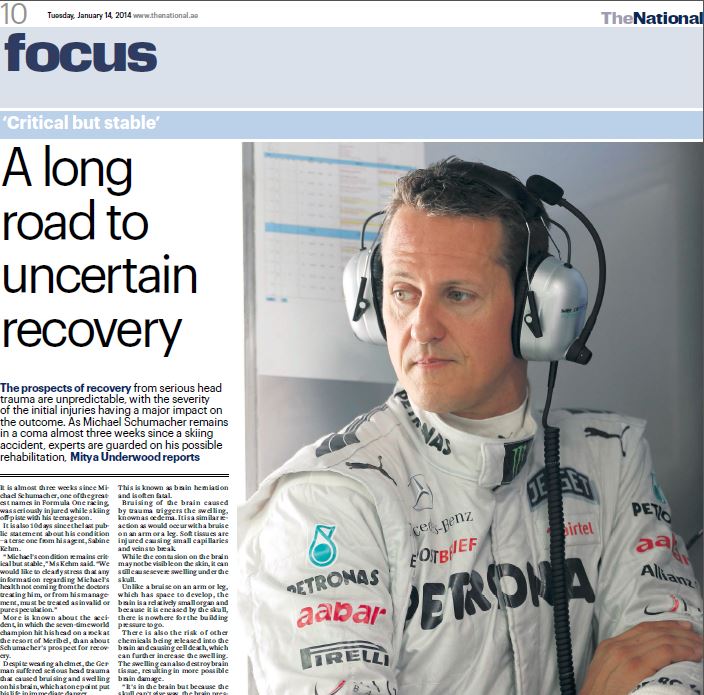
The National: German neurologist in Dubai, Dr Marquardt, speaks about Schumachers accident
Tuesday, January 14, 2014 www.thenational.ae
A long road to uncertain recovery
The prospects of recovery from serious head trauma are unpredictable, with the severity of the initial injuries having a major impact on the outcome. As Michael Schumacher remains in a coma almost three weeks since a skiing accident, experts are guarded on his possible rehabilitation, Mitya Underwood reports.
It is almost three weeks since Michael Schumacher, one of the greatest names in Formula One racing, was seriously injured while skiing off-piste with his teenage son. It is also 10 days since the last public statement about his condition – a terse one from his agent, Sabine Kehm. “Michael’s condition remains critical but stable,” Ms Kehm said. “We would like to clearly stress that any information regarding Michael’s health not coming from the doctors treating him, or from his management, must be treated as invalid or pure speculation.” More is known about the accident, in which the seven-time world champion hit his head on a rock at the resort of Meribel, than about Schumacher’s prospect for recovery. Despite wearing a helmet, the German suffered serious head trauma that caused bruising and swelling on his brain, which at one point put his life in immediate danger. Since then, Schumacher has been kept in a medically induced coma, with reports revealing no more than those three words: critical but stable. It is a term that reveals very little about a prognosis or his condition. “It really means nothing,” says Dr Jutta Marquardt, a German neurologist who runs an outpatient neurology clinic in Schweinfurt, and spends two weeks every month working in Dubai, UAE. “It doesn’t tell you how deep the coma is, or if he is in an artificial coma, or if he is in a natural coma. It’s just saying the patient is not getting worse and he is not getting better.” But Dr Marquardt, German Neuroscience Center Dubai, adds: “It is good to have him stable.” For an induced coma to be of any benefit, time is of the essence. The key is to prevent the brain from swelling to a point where it presses down on the base of the skull, where it connects with the spinal cord.
When the patient survives the first days it is quite a good prognosis Dr Jutta Marquardt neurologist, Dubai
This is known as brain herniation and is often fatal. Bruising of the brain caused by trauma triggers the swelling, known as oedema. It is a similar reaction as would occur with a bruise on an arm or a leg. Soft tissues are injured causing small capillaries and veins to break. While the contusion on the brain may not be visible on the skin, it can still cause severe swelling under the skull. Unlike a bruise on an arm or leg, which has space to develop, the brain is a relatively small organ and because it is encased by the skull, there is nowhere for the building pressure to go. There is also the risk of other chemicals being released into the brain and causing cell death, which can further increase the swelling. The swelling can also destroy brain tissue, resulting in more possible brain damage. “It’s in the brain but because the skull can’t give way, the brain pressure rises,” says Dr Marquardt, who works at the German Neuroscience Centre in Dubai Healthcare City. “There’s only a little space. This reduces brain circulation and presses the arteries and veins. You have to interrupt the cycle between the high pressure and the reduced brain circulation. “If the brain shifts down on to the spinal cord it means the patient will die because the brainstem is com-pressed.” To interrupt the cycle, doctors can administer barbiturates to put the patient into what is known as a medically induced coma. The barbiturates act as depressants to the central nervous system and reduce the metabolic rate of the brain. When the brain needs less energy, there will be less blood flow and therefore less pressure, giving the brain a chance to rest. “In an artificial coma you are in general narcosis. You are not able to breathe by yourself, you need mechanical ventilation,” Dr Marquardt, Neurologist in Dubai, says. “You need to have hyperventilation, high-frequency breathing, to reduce brain oedema. It stops a little bit of the circulation but mainly it reduces the swelling. “With younger people you can open the skull and give space [to the brain]. With younger people it’s much more dangerous because they have more water in the cells of their brain, so there’s less room for the brain to swell.” Doctors continue to monitor the patient’s condition and responsiveness to their surroundings. While the patient is technically alive, they cannot move or be woken. They will remain on a ventilator and other life support, such as feeding tubes, for months or longer. It is likely that in the initial stages of the coma the patient will be unresponsive to pain, but as time goes on and they move to a lighter coma, their reactions become stronger. “The faster you start with the coma the outcome will be better, of course,” Dr Marquardt, Neurologist in Dubai, says. “But you can have a living patient in a coma for months if necessary because you have the monitors. You must monitor the electroencephalography and cardiac functions. “How deep is the natural coma? You can see it by pain reaction or if he breathes against the mechanical ventilation.” The electroencephalography records the brain’s electrical activity using electrodes attached to the scalp. It is also used to assess patients with epilepsy or sleep disorders. Using such tools, doctors are able to establish how the brain of a coma patient is functioning. The most common coma measuring tool is the Glasgow Coma Scale, which gives patients a score be-tween 3 and 15, depending on the depth of their consciousness. Doctors measure eye response, verbal response and motor response. For the eye test, “does not open eyes” gives a score of 1, while “opens eyes spontaneously” points. Under the motor test, “extension to painful stimuli” is 2 points and “obeys commands” is 6. A severe coma is a score of 8 or less. Even while a patient is in a natural or artificial coma these tests determine their level of consciousness. A patient can be very much alive but with minimal brain activity. There have been a number of high-profile coma cases where patients have survived for decades before regaining consciousness or dying. Elaine Esposito, of Florida, US, who fell into a coma after being anaesthetised for an appendix operation, survived for 37 years but never regained consciousness. Another American, Terry Wallis, made headlines in June 2003 when he regained awareness after spending 19 years in a minimally conscious state. He slipped into a coma after a road accident in July1984. His condition changed to a minimally conscious state after 10 months. When he awoke in 2003, he was able to say some words, and neurologists established that he believed it to be 1984 and that he was still in his 20s. The recovery of a patient after a coma and brain injury very much depends on the type and severity of the initial injury. Mr Wallis remained disabled because of the injuries he suffered during the crash. Neurologists believed he was unable to store many new memories because of damage to his frontal lobe. This week, the former Israeli Prime Minister, Ariel Sharon, died after being in a coma, reliant on a feeding tube, for eight years. Sharon, 85, had a massive stroke in January 2006 and had a seven-hour operation to release the pressure of a brain haemorrhage. After several months and several further operations, he was moved to another hospital in Tel Aviv where he remained in a “serious but stable” condition until his death. It is almost impossible for neurologists to predict how a patient will recover from an induced or natural coma as so much of it depends on the initial injuries. The medical team at the Grenoble University Hospital where Schumacher is being treated, said the day after the accident that his condition and injuries meant they were unable to make any predictions about whether he would make a full recovery. “When the patient survives the first days it is quite a good prognosis because the brain cells are surviving,” Dr Marquardt, neurologist in Dubai says.
munderwood@thenational.ae


